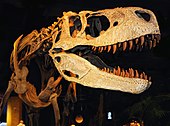Appalachiosaurus
| Appalachiosaurus | ||||||||||||
|---|---|---|---|---|---|---|---|---|---|---|---|---|

Live reconstruction of Appalachiosaurus |
||||||||||||
| Temporal occurrence | ||||||||||||
| Campanium ( Upper Cretaceous ) | ||||||||||||
| 83.6 to 72 million years | ||||||||||||
| Locations | ||||||||||||
| Systematics | ||||||||||||
|
||||||||||||
| Scientific name | ||||||||||||
| Appalachiosaurus | ||||||||||||
| Carr , Williamson & Schwimmer , 2005 | ||||||||||||
| Art | ||||||||||||
|
||||||||||||
Appalachiosaurus is a genus theropod dinosaur from the superfamily of the Tyrannosauroidea within the Coelurosauria , which lived about 77 million years ago in the late Cretaceous (middle Campanium ) in what is now North America ( USA ). The type species and only species in the genus is Appalachiosaurus montgomeriensis .
etymology
The genus name is derived from the site where the fossils and means something like " Appalachian - lizard ". The species name refers to Montgomery County .
Discovery and Description
The fossilized bones of the Appalachiosaurus holotype specimen ( RMM 6670 ) were discovered in 1982 by a team from Auburn University under the direction of geologist David King in the Demopolis Chalk Formation in Alabama and in 2005 by paleontologists Thomas Carr, Thomas Williamson and David Swimmers described and named. The scientists also assigned fossil material from the Donoho Creek Formation in South Carolina and the Tar Heel Formation in North Carolina to the species Appalachiosaurus montgomeriensis .
Features and appearance
Appalachiosaurus is considered to be the first described and so far most complete genus of the Tyrannosauroidea from the eastern United States. Like almost all theropods, Appalachiosaurus was a bipedal predator . The skeleton of a juvenile animal was found from this carnivore , about two-thirds of which was fully grown. This holotype specimen was a little more than 6 meters long and probably weighed around 600 kg. The find consists of parts of the skull with the lower jaw, several vertebrae, parts of the pelvis and almost complete hind legs. He had a long, narrow skull with a flat jaw and probably two short, stunted arms with two fingers each.
Systematics
Phylogenetic analyzes showed that Appalachiosaurus can be classified as a basal tyrannosauroid. Earlier representatives of the tyrannosaurs such as Dilong and Guanlong had not yet been described at the time of the analysis. These exclusions could have a significant impact on phylogeny. Below is a cladogram by Loewen et al . from 2013:
|
|
|
||||||||||||||||||||||||||||||||||||||||||||||||||||||||||||
|
|
Web links
Individual evidence
- ↑ Thomas D. Carr, Thomas E. Williamson, David R. Schwimmer: A new genus and species of tyrannosauroid from the Late Cretaceous (Middle Campanian) Demopolis Formation of Alabama . In: Journal of Vertebrate Paleontology . tape 25 , no. 1 , March 11, 2005, ISSN 0272-4634 , p. 119-143 , doi : 10.1671 / 0272-4634 (2005) 025 [0119: ANGASO] 2.0.CO; 2 .
- ↑ Chase D. Brownstein: The biogeography and ecology of the Cretaceous non-avian dinosaurs of Appalachia . In: Palaeontologia Electronica . tape 21 , no. 1 , February 8, 2018, ISSN 1094-8074 , p. 1-56 , doi : 10.26879 / 801 ( palaeo-electronica.org [accessed April 21, 2019]).
- ↑ Appalachiosaurus montgomeriensis - Description, Dinodata.de. Retrieved April 21, 2019 .
- ↑ Mark A. Loewen, Randall B. Irmis, Joseph JW Sertich, Philip J. Currie, Scott D. Sampson: Tyrant Dinosaur Evolution Tracks the Rise and Fall of Late Cretaceous Oceans . In: PLoS ONE . tape 8 , no. 11 , November 6, 2013, ISSN 1932-6203 , doi : 10.1371 / journal.pone.0079420 , PMID 24223179 , PMC 3819173 (free full text).
